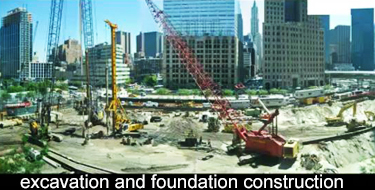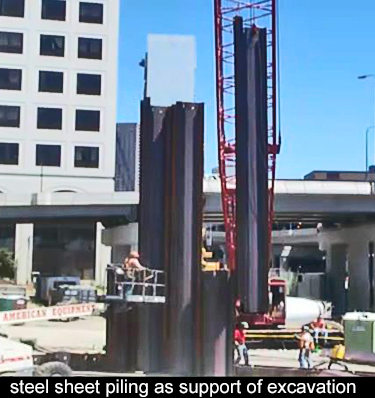In this series of classes, we will explore vertical construction, which is high-rise construction. We begin with a commercial building in lower Manhattan, which is constructed with a steel frame, which is typical of very tall commercial towers.
 This is an overall view of the site. It is in lower Manhattan. The site is below the water table. The perimeter of the site is protected by steel sheet piling. You can see some of the early activities here. The sheet piling has already been installed. That was the first activity. Now, the general excavation is underway - also the installation of high-capacity caissons, which will be the support for the office tower.
This is an overall view of the site. It is in lower Manhattan. The site is below the water table. The perimeter of the site is protected by steel sheet piling. You can see some of the early activities here. The sheet piling has already been installed. That was the first activity. Now, the general excavation is underway - also the installation of high-capacity caissons, which will be the support for the office tower.

This is a view of steel sheet piling, which is being installed. This is a different site. This is actually the big dig in Boston. What I want to point out here is that there is a pattern that's necessary for establishing the steel sheet piling. To begin with, this contractor placed a horizontal member down on the ground. It looks like some rolled shape, whatever is convenient, and he's going to use that as a template as a guide to align the sheets properly.
Steel sheet piling, as you probably know, is interlocking one sheet interlocks with the next. That gives it this unique watertight configuration. That's what makes this very, very valuable. However, there's a pattern here, which really needs to be observed. These sheets have been fully driven, and this sheet is substantially driven, and these are just partially driven. You want to build up groups of sheets in that manner.
The danger is some people drive each sheet for its full height, and then attach the next sheet and drive that one. It's really very risky to do it that way, because if the sheet is even slightly out of plumb, the next sheet simply follows the path of the first sheet. There's very little opportunity, I would say no opportunity, for correcting that out of plumb this. If anything, there's the risk of accumulating these errors to the point where the sheets are farther and farther out of plumb. The idea is to erect a number of sheets at the same time, and then fall back and drive some a little further. Then, perhaps, add some more sheets and fall back and drive the earliest sheets a little further. Proceed in that manner and that gives you flexibility in maintaining the plumb-ness and the alignment of the sheets.